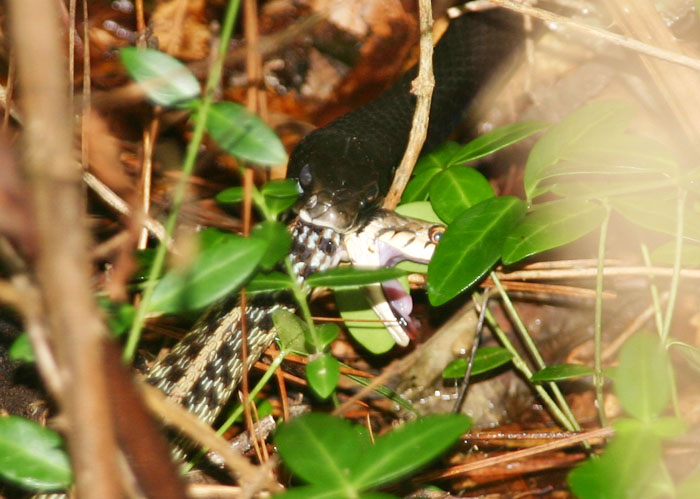
Okay, this is kind of a frustration. It’s also kind of an accomplishment. What you’re seeing above is a northern black racer (Coluber constrictor constrictor) that has just captured an eastern garter snake (Thamnophis sirtalis sirtalis).
I was cutting up a trail through the woods while at work when I heard a rustle practically at my feet. One of the things I teach in my classes and seminars is about finding photos with your ears – sounds can lead you to photographic subjects quite frequently. In this case, it led to what I initially took to be a black rat snake alongside the trail, roughly a meter long. His head was hidden from view, and curiously, after the initial sharp rustle, he was motionless. I started edging around to get a better view of his head, and spotted the body of the hapless garter snake, still writhing. I wasted no time in scampering up to the parking lot and snagging my camera from the car, as well as my cell phone, which I used to summon a couple of co-workers up to see this. While I waited, I stayed still and unobtrusive so as not to spook the snake under cover. The snake had made it clear it knew I was around as I returned with the camera, because it gave a vigorous vibration of the tail.
[A quick side note: Many snake species, not just rattlesnakes, vibrate their tail as a warning. Rattlesnakes just have a handy noisemaker. But other species can produce much the same noise as the tail drums against dry leaves, and it’s an impressive sound, let me tell you.]
Once the others had their opportunity to see it, I maneuvered into the brush a bit to get a better view of the head, and eventually secured a nice keyhole in the brush that allowed me to see the dramatic scene above. The accomplishment part of this was even seeing such behavior, much less getting a reasonably clear shot of it. Snakes feeding in the wild are incredibly hard to find. They know they are quite vulnerable during and immediately after a capture, and usually, to even effect a capture in the first place, they have to be motionless until prey comes within reach. We humans, with our noisy blundering way of moving about (even me), tend to let every species within earshot know we’re about. Now, snakes don’t have ears, but they can feel vibrations through the ground, so while we’re slightly more subtle to them, it’s not by a huge margin.
The frustration part of this was twofold. The first is that it was difficult to get any kind of view at all of the drama, as it were. Even cropped tight as this is, you can see in the photo the out-of-focus brush to either side of the subject (the tan haze to the right side is a branch too close to the camera to be in any kind of focus, but still illuminated by the camera flash), and this was as good as I was going to get. Trying to get closer would either have spooked the snake into deeper cover or caused it to release its prey. And as I said, it was well aware that I was around, and not happy about it. Thus the second part of the frustration: while I would have loved to photograph the remainder of the story, there was no way it was going to happen. The snake would undoubtedly have moved into deep cover to finish the meal.
As I thought about this afterwards, I realized I might have even been a factor in this tableau. Considering that I witnessed the death throes of the garter once I spotted it, this meant that the racer’s strike had not occurred long before, and was perhaps even the rustle sound itself. Coupled with their proximity to the trail, my sudden presence might have spurred the garter into the racer’s range, or maybe even have fatally broken its attention from a faceoff between the two.
Now, here are two things of interest from this particular shot. The first is that, the difference in the size of the two snakes is not a big one (though it’s hard to determine from just this image). This is a significant meal for the racer, and would last it at least a month from my estimate.
The second is a subtle one that adds a lot to the scene without, I suspect, most people realizing it. Snakes don’t have eyelids, and don’t change expression in any way. Both species have a natural ridge above the eyes that we tend to see as an eyebrow, and gives them a slightly mean frown to our eyes. In this case, the angle of the garter’s head hides the ridge and gives it a wide-eyed look, while the angle of the racer’s exaggerates the ridge and makes it look nasty. Given the poses, we automatically expect such expressions, but there’s no expression there for either of them. What we imagine we see, however, fits with the brutality we assign to this action. It’s important to remember that we can’t assign human traits to this, and what we’re seeing is simply normal behavior in a world we pay too little attention to. There’s no animosity, no emotion – the racer was hungry, and the garter not fast enough. So it goes.




















































